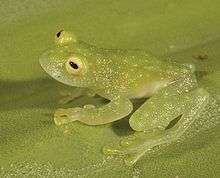Hyalinobatrachium pellucidum
Hyalinobatrachium pellucidum, also known as the Rio Azuela glass frog, is a species of frog in the family Centrolenidae.[3][4] It is found in lower montane rainforests on the Amazonian Andean slopes in Ecuador and Peru.[3] The specific name pellucidum is Latin for "transparent" and refers to the transparent parietal peritoneum of this species.[2]
| Rio Azuela glass frog | |
|---|---|
 | |
| Scientific classification | |
| Kingdom: | Animalia |
| Phylum: | Chordata |
| Class: | Amphibia |
| Order: | Anura |
| Family: | Centrolenidae |
| Genus: | Hyalinobatrachium |
| Species: | H. pellucidum |
| Binomial name | |
| Hyalinobatrachium pellucidum (Lynch and Duellman, 1973) | |
| Synonyms | |
|
Centrolenella pellucida Lynch and Duellman, 1973[2] | |
Description
This frog is about the size of a fingernail: males measure 20–22 mm (0.79–0.87 in) and females about 22 mm (0.87 in) in snout–vent length. The snout is truncated. The tympanum is partially hidden under skin. Dorsal skin is slightly granular. The dorsum is pale green with diffuse yellow dots. The fingers and toes are yellow and partly webbed. Lower surfaces are unpigmented and the heart is visible through the parietal peritoneum. The iris is pale silver bronze.[4]
The male advertisement call is a single, monotone note, without amplitude modulation.[5]
Habitat and conservation
Its natural habitats are lower montane rainforests, cloud forests, as well as old-growth and secondary forests at elevations of 500–1,740 m (1,640–5,710 ft) above sea level. Individuals have been found at night on the upper surfaces of leaves of trees and herbs, about 1.5 to 4 metres above streams.[1][5] Egg clutches are laid in vegetation where they may fall victim to predation from spiders.[5]
The species is threatened by habitat loss caused by smallholder farming and logging.[1] Ex-situ conservation programs have begun to help save this interesting creature.[6]
References
- IUCN SSC Amphibian Specialist Group (2014). "Hyalinobatrachium pellucidum". IUCN Red List of Threatened Species. 2014: e.T47255219A47255232. doi:10.2305/IUCN.UK.2014-1.RLTS.T47255219A47255232.en.
- Lynch, J. D. & Duellman, W. E. (1973). "A review of the centrolenid frogs of Ecuador, with descriptions of new species". Occasional Papers of the Museum of Natural History, University of Kansas. 16: 1–66.
- Frost, Darrel R. (2017). "Hyalinobatrachium pellucidum (Lynch and Duellman, 1973)". Amphibian Species of the World: an Online Reference. Version 6.0. American Museum of Natural History. Retrieved 17 June 2017.
- Guayasamín, J. M.; et al. (2018). Ron, S. R.; Merino-Viteri, A. & Ortiz, D. A. (eds.). "Hyalinobatrachium pellucidum". Anfibios del Ecuador. Version 2019.0. Museo de Zoología, Pontificia Universidad Católica del Ecuador (QCAZ). Retrieved 22 May 2020.
- Twomey, E.; Delia, J. R. J. & Castroviejo-Fisher, S. (12 August 2014). "A review of Northern Peruvian glassfrogs (Centrolenidae), with the description of four new remarkable species". Zootaxa. 3851 (1): 1–87. doi:10.11646/zootaxa.3851.1.1.
- "Phibi and her family of wampukrum harlequin toads get help". Philadelphia Zoo. 2015. Archived from the original on 22 March 2016. Retrieved 20 March 2016.
